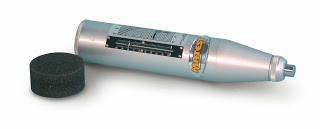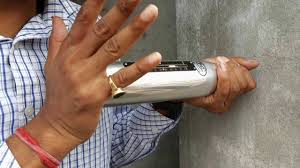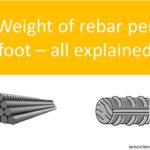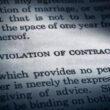 |
| Rebound Hammer Test |
Principle of Rebound Hammer Test
The rebound hammer test is based on the principle that the rebound of an elastic mass depends on the hardness of the surface against which the mass impinges. However, despite its apparent simplicity, the rebound hammer test involves complex problems of impact and the associated stress-wave propagation.
Working of Rebound Hammer Test
In the rebound hammer test a spring – loaded mass has a fixed amount of energy imparted to it by extending the spring to a fixed position; this is achieved by pressing the plunger against the surface of the concrete under test. Upon release, the mass rebounds from the plunger, still in contact with concrete surface, and the distance travelled by the mass, expressed as a percentage of the initial extension of the spring, it is called the rebound number.
This number is indicated by a rider moving along a graduated scale. Some hammer models produce a print-out of test results. The rebound number is an arbitrary measure because it depends on the energy stored in the given spring and on the size of the mass.
Limitations of Rebound Hammer Test
The hammer has to be used against a smooth surface, preferably a formed one. Open-textured concrete cannot, therefore, be tested. Trowelled surfaces should be rubbed smooth using a carborundum stone. If the concrete under test does not form part of a larger mass, it has to be supported in an unyielding manner, as jerking during test would result in lowering of the rebound number recorded.
The test is sensitive to local variations in the concrete; for instance, the presence of a large piece of aggregate immediately underneath the plunger would result in an abnormally high rebound number; conversely, the presence of a void in a similar position would lead to a low result. Moreover, the energy absorbed by the concrete is related both to its strength and its stiffness, so that it is the combination of strength and stiffness that governs the rebound number. Because the stiffness of concrete is influenced by the type of aggregate used, the rebound number is not uniquely related to the strength of concrete.
The plunger must always be normal to the surface of the concrete under test, but the position of the hammer relative to the vertical will affect the rebound number. This is due to the action of gravity on the travel of the mass in the hammer. Thus, the rebound number of a floor is smaller than that of a soffit of the same concrete, and inclined and vertical surfaces yield intermediate values. For this reason, and also because of other factors which influence the rebound number, the use of ‘global’ diagrams relating the hardness number and strength is inadvisable.
The concrete procedure is to establish experimentally the relation between the rebound number measured on compression test specimens and their actual strength. If possible, the specimen mould material should be the same as the formwork material in the structure.
Like Us on Facebook!
While the position of the curves relating the compressive strength to the rebound number varies, typically, for a change in the strength of approximately 5 MPa there is a change of 4 units in the rebound number. This relation is given only by way of illustration and cannot be relied upon to detect small differences in strength. It should be noted that different rebound hammers, even of the same design, cannot be assumed necessarily to give the same rebound number.
Subscribe Us on YouTube!
In any case, the rebound hammer test measures the properties of only the surface zone of concrete; the depth of this zone is about 30 mm. Changes affecting only the surface of the concrete, such as the degree of saturation at the surface or carbonation, have little influence on the properties of the concrete at depth.
Because of local variability in the hardness of concrete over a small area, the rebound number should be determined at a number of locations in close proximity, but according to ASTM C 805-08 not closer than 25 mm ( 1 in.) apart. British standard BS 1881-202; 1986 (withdrawn) recommends testing on a grid pattern with a spacing of 20 to 50 mm within an area not larger than 300 by 300 mm; this reduce the operator bias.
Disadvantages of Rebound Hammer
The rebound hammer test is largely comparative in nature and, as such, is useful in the assessment of uniformity of concrete within a structure or in the manufacture of a number of similar products such as precast elements. The test can also be used to establish whether the rebound number has reached a value known to correspond to the desired strength. This is of help in deciding when to remove falsework or to put the structure into service. Another use of the hammer is to check whether the strength development of a given concrete has been affected by frost at an early age, but according to ASTM C 805-08, still frozen concrete may give very high rebound number.
A particular application of the rebound hammer test is in accessing the abrasion resistance of the concrete floors, which largely depends on surface hardness.
Overall, while the rebound hammer test is useful within a limited scope, this test in not a strength test and exaggerated claims of its use as a replacement of compression test should not be accepted.
















This comment has been removed by a blog administrator.
This comment has been removed by a blog administrator.